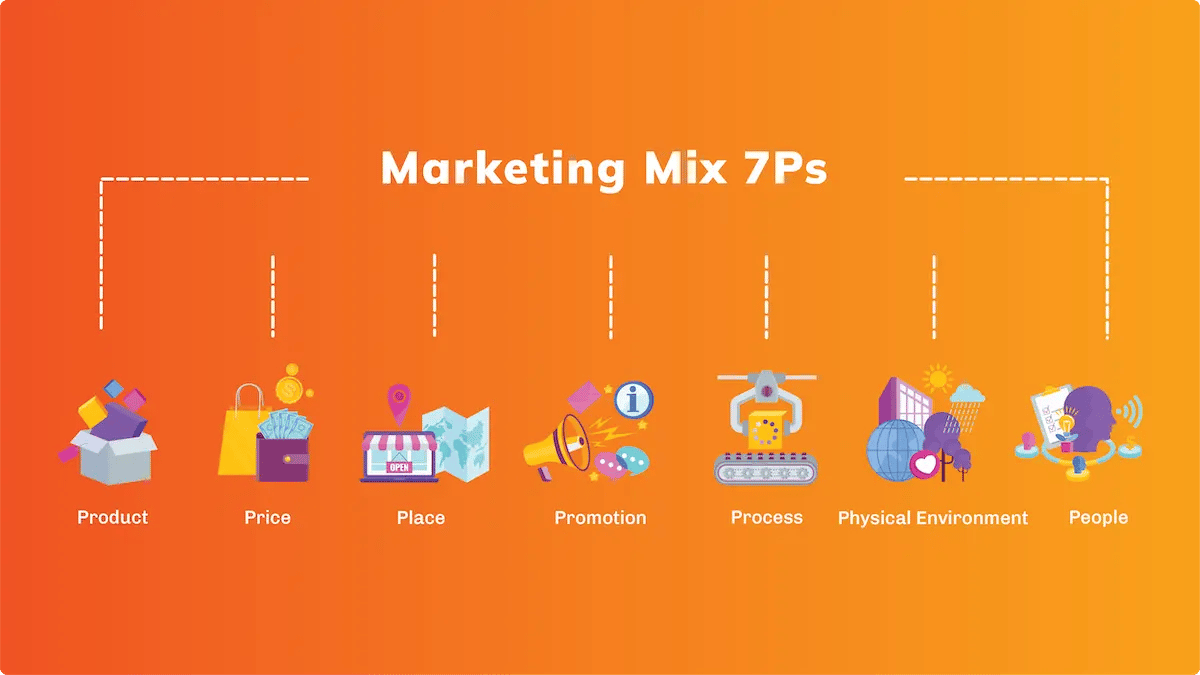The 7Ps of the Marketing Mix: Accelerate Your Strategy
The term “marketing” is often used as a catchall to depict any activity a company undertakes to promote and sell its products and services to its consumers. No matter what industry that company may be in, marketing efforts can be all-encompassing.
They also include nearly every aspect of the business cycle from analytics to product development and distribution channels to sales--all filtered through a general understanding of customer needs.
Over the years, to better understand the complexities of marketing, several business experts have created systems to help businesses better analyze and understand their marketing strategy. One of these models that have truly stood the test of time is the 7Ps Marketing Mix. Developed in the 1960s but still widely used today, this iconic model aims to simplify the marketing process.
Ready to see how it works? Read on to find out!
7Ps of the Marketing Mix |
What are the 7Ps of the Marketing Mix?
The 7Ps Marketing Mix is a comprehensive set of action plans businesses can use to market their products or services to their target audience. While it provides a coherent framework for evaluating performance, it also assists brands in determining the best combination of elements to establish clear objectives and approaches based on their current situation.
The seven elements are product, price, place, promotion, people, process and physical evidence.

1. Product
Product refers to what you create and delivers to meet your customer's core needs. When bringing a new product or service to market, several factors must be considered, including quality, features, and packaging, as well as what problem your product helps solve.
Companies can use the 7Ps framework to make informed decisions and develop a unique selling proposition (USP) as consumer needs change and new competitors emerge over time. This helps businesses scale and stay relevant in today’s ever-changing market while consistently providing a positive product experience.
Product differentiation strategies also take things into account such as after-sales support, user-friendly apps, and interactive digital content, all to meet or exceed customer expectations.
2. Price
Price reflects the maximum value customers are willing to pay for your product or service. Determining the right price requires extensive research and is dependent on the product you are selling as well as your brand image.
Factors such as production costs, the economy at large and market demand all play a role in determining price. However, price is also an important indicator of market positioning and should always be set with your competitors in mind.
3. Place
Place represents the distribution channels through which customers can make a purchase. It could be in a brick-and-mortar store, website or mobile app.
Getting the right product in the right place at the right time ensures that your product or service is available when and where your customers need it. It encompasses the intermediaries and logistics that occur before they are made available to end users.
Place is an often overlooked part of the marketing process. If your products aren’t being sold in locations that fit your brand and your target consumer’s lifestyles, it will severely impact your sales and profits.
4. Promotion
When it comes to promotion, the goal is always to increase brand awareness in an effort to attract new customers while reminding loyal customers of your brand and encouraging them to come back.
Promotional marketing can take many forms including TV advertising, personal selling, public relations, and more recently, paid digital media and Search Engine Optimization (SEO) strategies. Taking a multi-faceted approach with different promotional avenues allows businesses to have a wider reach while they connect to and build relationships with their customers.
The challenge comes in determining which promotional tools your audience responds best.
Consider performing a regular SWOT (strengths, weakness, opportunities and threats) analysis to understand how your business compares to your competitors. This will allow you to capitalize on new growth opportunities and develop actionable strategic plans.
5. People
The next 3Ps in the model: people, process and physical evidence were introduced in the early 1980s when customer service was becoming more recognized as an integral part of marketing.
People are the building blocks of successful organizations that underpin great customer relationships. This includes anyone who is directly or indirectly involved with your business. From salespeople to the human resource department and customer service team, they play a crucial role in representing your company.
Customer-facing teams, in particular, need support from other departments and the right tools and resources in place to provide the best service possible. They understand the ins and outs of your business and have in-depth product knowledge, both of which must be optimized.
Tapping into their passion and investing in training allows your company to differentiate its offering in a saturated market and build valuable customer relationships. These are also excellent ways to empower and retain high-performing employees to work towards common goals.
When it comes to building and managing customer support teams, there is no one-size-fits-all solution. Each organization needs to have its own set of goals. However, this doesn’t mean you can’t learn from successful companies and figure out how to apply some of their approaches to your company’s unique situation.
6. Process
“Process” describes the sequence of actions involved in delivering the product to the end users. Understanding each stage of the customer journey is critical. From when they are just learning about your brand to post-sales, you must consider what approaches are required to make sure your customers have a positive experience.
To ensure that your customers receive end-to-end care and a smooth transition across all touchpoints, you must carefully consider each phase in the sales process to ensure they have a positive experience every step of the way.
7. Physical Evidence
The final piece of the 7Ps puzzle? Physical evidence of their positive interaction with you. Modern storefronts, user-friendly websites, well-trained employees and even something as simple as a thank-you note provide customers with the physical evidence they need to be confident that your company is viable and trustworthy.
It can be helpful when prospective or first-time customers have not previously interacted with your company and require some reassurance before making the final purchase. First and last impressions are important and simple reminders of your company’s validity can go a long way in solidifying your brand reputation in the mind of your current and potential customers.
Conclusion
The Ps Marketing Mix can help businesses develop a winning brand strategy that allows them to differentiate themselves from competitors and earn their trust. While this is one of the oldest marketing models out there, it is still highly trusted–simply because it works. If you want to continue to grow your brand and expand your marketing efforts, this straightforward model can be one of your most trusted tools to make it happen.
Regularly assessing and adjusting these processes can attract and retain valuable customers while keeping their business profitable.
 You've made it this far and you've learned so much. Congratulations!
You've made it this far and you've learned so much. Congratulations!
If you're looking to learn more about marketing or Ecommerce in general, feel free to reach out to us at: solutions@undigital.com
You May Also Like
These Related Stories

Marketing Product Lifecycle Guide - The Ups and Downs

Ecommerce Email Marketing Strategies and Tips


